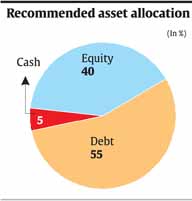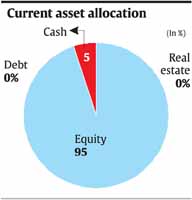Publication: DNA Mumbai; Date: May 22, 2006: Section: Personal Finance Page: 24

 With the Sensex crashing last week, everybody has been trying to answer what do we do now? But my take on it is, does it really matter? Do we really have to try and beat the market?
With the Sensex crashing last week, everybody has been trying to answer what do we do now? But my take on it is, does it really matter? Do we really have to try and beat the market?
Let me quote an example from the book the Intelligent Investor by Benjamin Graham, that sums up my point, “I once interviewed a group of retirees in Boca Raton, one of Floridas wealthiest retirement communities. I asked these people mostly in their seventies – if they had beaten the market over their investing lifetimes. Some said yes, some said no; most werent sure. Then one man said, “Who cares? All I know is, my investments earned enough for me to end up in BOCA”.Could there be a more perfect answer. After all the whole point of investing is not to earn more money than average, but to earn enough money to meet your own needs. As Ben Graham says, “the best way to measure your financial success is not by whether you are beating the market but by whether you have put together a financial plan and a behavioural discipline that are likely to get you where you want to go.”
So I asked myself, “What is more important to people in their investing career, the Sensex or the goals for which they need money?”
It wouldnt matter at what level the Sensex is in if you need Rs 2 lakh to enjoy an SOTC Europe Tour or you had to pay for your childs education. Hence, it is paramount that instead of giving undue importance to where the Sensex is, focus on some basics.
“What do you mean by create your own Sensex or Nifty?” asked Ramesh Naik when he came to me for advice on his portfolio.
It means knowing what returns you need to earn on your savings or investments to achieve your financial goals or dreams and creating a portfolio of assets keeping in mind your tolerance to risk that helps you achieve financial nirvana.
Naik is a retired man whose only source of income is his hard earned money and some real estate, which is under litigation.
His son is in the US and most of the responsibilities are taken care off by him. Naiks only goal is to earn an income out of his investments so that he can maintain a certain kind of lifestyle. We took a hard look at where he was and it seemed that he needed around 8% return to achieve his income goals. To provide for any medical emergency that might crop up in addition, Naik has an insurance cover of around Rs 2 lakh and has accumulated some no-claim bonus.
While doing his risk profile, Naik said that he is conservative investor and does not want to lose money. On examining his portfolio we found that almost 95% of his investment was in equity and the remaining was cash. However, the more surprising fact was that most of the equity investments were in aggressive mid-cap oriented funds.
Not only this, he had also borrowed money to invest in equities as advised by his broker.
I asked him, “When you are so conservative and do not like to risk principal, why are you doing things that are not in alignment with your thoughts?” “I am making good money and this is working for me,” he replied to me. Some contradiction this was. “You might make money in the short-term when the going is good, but this strategy might burn your hands badly in the long run,” I replied. Financial goals
Naiks present financial goals are:
1) Post-tax income of Rs 50,000 per month for the next 25 years.
2) To invest Rs 50 lakh from his share of property sale.
3) Medical expenses for self and wife
4) To visit his son in the US once a year, which will cost him around Rs 2.5 lakh.
Risk profile
Naik has accumulated a sizeable corpus, which indicates that he has the capacity to take risks but not an investment in equity of as high as 95%.
However, at the same time he did not want to lose the money that he had invested. We assessed his risk profile to be conservative and then created an asset allocation that will help him post-tax return of 8% that was necessary to achieve most of his goals.
The current and recommended asset allocations are given in the charts
Investment strategy
After taking stock of capital gain implications, we got rid of most of the mid-cap funds and aggressive stocks.
We rebalanced the portfolio and added large cap and balanced funds for the equity exposure.
For the debt exposure, we maxed out the investment of Rs 15 lakh in the senior citizen savings scheme and Rs 3 lakh in post office monthly income scheme.
Next step was to invest a sufficient amount in RBI Bonds and NSCs to create a ladder of bonds (a steady stream of income by spreading bond investments over a period of time).
Additionally, we took exposure to some of the monthly income plans for the income needs.
nWe opted for the dividend payout option of most of the funds and invested in some of high dividend paying stocks.
We kept some cash holdings for emergency reserves and some of which could be used as opportunistic cash.
After this, Naik felt more confident of the overall impact of equities on his portfolio, and in control that he could sleep even after the recent Sensex correction. He now believes in concentrating more on the returns he reasonably needs to achieve his goals.
Knowing your Sensex (benchmark) can help you avoid assume more risk than necessary.
In the end what matters isnt crossing the finishing line before anybody else, but just making sure you do cross it too.
The writer is a certified financial planner and runs his own financial planning outfit called My Financial Advisor. He can be reached at myplan@fpsbindia.org.
To read the original article click here


